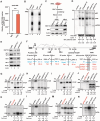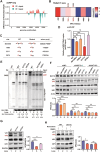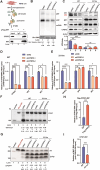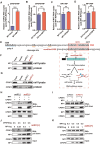N4-acetylcytidine coordinates with NP1 and CPSF5 to facilitate alternative RNA processing during the replication of minute virus of canines
- PMID: 40167508
- PMCID: PMC11959542
- DOI: 10.1093/nar/gkaf229
N4-acetylcytidine coordinates with NP1 and CPSF5 to facilitate alternative RNA processing during the replication of minute virus of canines
Abstract
RNA modifications play crucial roles in RNA metabolism, structure, and functions. N4-acetylcytidine (ac4C) modifications have been shown to enhance stability and translation efficiency of messenger RNAs and viral RNAs. However, the relationship between ac4C and alternative RNA processing remains unexplored. Here, N-acetyltransferase 10 (NAT10) and its catalyzed ac4C modifications on minute virus of canines (MVC) were shown to regulate viral DNA replication and RNA processing, including both the alternative RNA splicing and polyadenylation. Through acRIP-seq and RedaC:T-seq, functional ac4C-modified residue 3311 was identified and characterized, which affected MVC RNA processing rather than altered the viral RNA stability. Ac4C modification at nt 3311 was revealed to participate in NP1-mediated viral RNA processing without influencing RNA affinity of NP1. Meanwhile, CPSF5 was identified to interact with NP1 and mediate viral RNA processing in an ac4C-dependent manner. Further in vitro assays showed that NP1 recruited CPSF5 to MVC RNAs, and the ac4C modification promoted specific binding of CPSF5 to the target region, which ensured precise alternative MVC RNA processing. This study not only reveals the functions of NAT10 and ac4C but also elucidates the mechanisms by which RNA modifications orchestrate MVC proteins and host factors for efficient viral replication and alternative RNA processing.
© The Author(s) 2025. Published by Oxford University Press on behalf of Nucleic Acids Research.
Conflict of interest statement
None declared.
Figures







Similar articles
-
N-acetyltransferase 10 regulates alphavirus replication via N4-acetylcytidine (ac4C) modification of the lymphocyte antigen six family member E (LY6E) mRNA.J Virol. 2024 Jan 23;98(1):e0135023. doi: 10.1128/jvi.01350-23. Epub 2024 Jan 3. J Virol. 2024. PMID: 38169284 Free PMC article.
-
Minute Virus of Canines NP1 Protein Governs the Expression of a Subset of Essential Nonstructural Proteins via Its Role in RNA Processing.J Virol. 2017 May 26;91(12):e00260-17. doi: 10.1128/JVI.00260-17. Print 2017 Jun 15. J Virol. 2017. PMID: 28356522 Free PMC article.
-
NP1 Protein of the Bocaparvovirus Minute Virus of Canines Controls Access to the Viral Capsid Genes via Its Role in RNA Processing.J Virol. 2015 Dec 4;90(4):1718-28. doi: 10.1128/JVI.02618-15. Print 2016 Feb 15. J Virol. 2015. PMID: 26637456 Free PMC article.
-
N4-acetylcytidine and other RNA modifications in epitranscriptome: insight into DNA repair and cancer development.Epigenomics. 2025 Apr;17(6):411-422. doi: 10.1080/17501911.2025.2473308. Epub 2025 Mar 5. Epigenomics. 2025. PMID: 40040517 Free PMC article. Review.
-
Emerging role of N-acetyltransferase 10 in diseases: RNA ac4C modification and beyond.Mol Biomed. 2025 Jul 1;6(1):46. doi: 10.1186/s43556-025-00286-3. Mol Biomed. 2025. PMID: 40588654 Free PMC article. Review.
Cited by
-
Parvovirus RNA Processing: Compact Genomic Organization and Unique Alternative mRNA Processing Mechanisms.Viruses. 2025 Jul 15;17(7):984. doi: 10.3390/v17070984. Viruses. 2025. PMID: 40733601 Free PMC article. Review.
References
MeSH terms
Substances
Grants and funding
LinkOut - more resources
Full Text Sources
Research Materials

